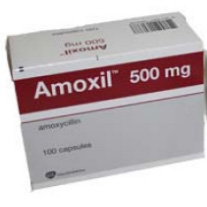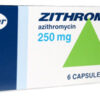Medication Overview
Amoxil, known generically as amoxicillin, is a penicillin antibiotic used to treat various bacterial infections. It belongs to the beta-lactam class of antibiotics, which work by inhibiting cell wall synthesis in bacteria. Prescribed primarily for infections like otitis media, skin infections, respiratory tract infections, and urinary tract infections, Amoxil is effective against a broad range of gram-positive and some gram-negative bacteria.
Pharmacological Class
Amoxil falls under the aminopenicillin subclass of penicillin antibiotics. These antibiotics are structurally related to penicillin but have a broader spectrum of antimicrobial activity. They act by binding to penicillin-binding proteins, which inhibits bacterial cell wall synthesis critical for bacterial survival. This disrupts cellular integrity and results in bacterial cell lysis.
Mechanism of Action
The active component in Amoxil, amoxicillin, targets the peptidoglycan layer of bacterial cell walls. It acts by inhibiting the transpeptidation or cross-linking of the bacterial cell wall’s peptidoglycan polymer chains. The compromised structural integrity of the bacterial wall leads to cell death. Amoxicillin is susceptible to degradation by beta-lactamase enzymes, which are produced by some bacteria to resist antibiotic action.
Indications and Usage
Amoxil is indicated for the treatment of certain infections caused by susceptible strains of bacteria. These include infections of the ear, nose, throat, genitourinary tract, skin, and respiratory system. It is also used in combination with other medications for the eradication of Helicobacter pylori infection as part of a regimen to reduce the risk of duodenal ulcer recurrence.
Dosage and Administration
The dosage of Amoxil varies depending on infection type, age, and weight of the patient. For adults, the typical oral dose ranges from 250mg to 500mg every 8 hours or as directed by a healthcare professional. Pediatric doses are calculated based on body weight at a typical dose of 20 to 40 mg/kg/day in divided doses. Amoxil can be taken with or without food.
Drug Interactions
Amoxil may interact with certain medications such as allopurinol, which can increase the risk of skin rashes. It can also reduce the effectiveness of oral contraceptives. Concurrent use with bacteriostatic antibiotics, such as tetracyclines, might affect the efficacy of Amoxil. Interaction with probenecid can result in increased and prolonged blood levels of amoxicillin.
Absorption and Distribution
Amoxicillin is absorbed rapidly and effectively from the gastrointestinal tract. Food does not affect its absorption significantly, permitting flexibility with dosing. Peak plasma concentrations occur one to two hours after administration. The drug is widely distributed in body tissues and fluids, though low levels of amoxicillin reach the central nervous system unless there is inflamed meninges, facilitating its action in meningitis cases.
Metabolism and Excretion
Amoxicillin is minimally metabolized in the body. It is primarily excreted unchanged in the urine, indicating a renal route of elimination. Approximately 60-70% of an orally administered dose is excreted in urine within the first six hours. Due to its renal clearance, dose adjustments may be necessary for individuals with renal impairment.
Potential Side Effects
Common side effects include gastrointestinal disturbances such as diarrhea, nausea, and vomiting. Some patients may experience hypersensitivity reactions like skin rash or urticaria. Rare but serious side effects include anaphylaxis, Stevens-Johnson syndrome, and antibiotic-associated colitis. Monitoring for allergic reactions is advisable, especially in patients with a history of penicillin allergy.
Storage Instructions
Amoxil should be stored at room temperature, away from excessive moisture and heat. The liquid suspension should be refrigerated and discarded after 14 days if unused, ensuring it is kept out of reach of children. Tablets and capsules must remain in their original packaging until ready for use to maintain stability and potency.
Special Populations Considerations
In pregnant or breastfeeding women, Amoxil is generally considered safe but should be used only if clearly needed. Dose adjustments might be required for patients with renal or hepatic impairment. Pediatric and elderly patients may require special dosing considerations, and close monitoring is recommended.
Enroll Your Experience
Patients using Amoxil should report any adverse reactions or unexpected effects to their healthcare provider promptly. This feedback is crucial for ongoing patient safety and pharmacovigilance. Healthcare providers rely on patient-reported outcomes to optimize antibiotic usage and mitigate potential risks associated with therapy.
Clinical Efficacy Studies
Clinical trials have demonstrated the efficacy of Amoxil in treating a variety of infections, with significant success rates in eradicating targeted bacteria. Data from placebo-controlled studies highlight its superior efficacy compared to placebo, especially in treating acute otitis media and sinusitis. Further studies underscore its role in combination therapy for Helicobacter pylori eradication.
Laboratory Monitoring
Monitoring of renal and hepatic function may be necessary for patients undergoing prolonged treatment with Amoxil. Patients should have periodic blood tests to detect possible side effects such as leucopenia or thrombocytopenia. Ensuring kidney function assessment is vital, particularly in those receiving concurrent nephrotoxic drugs or in cases of pre-existing renal dysfunction.
Resistance Concerns
Resistance to amoxicillin can occur due to bacterial production of beta-lactamase enzymes. Overuse or misuse of antibiotics can contribute to the development of resistant bacterial strains. Healthcare professionals are urged to prescribe Amoxil only based on susceptibility testing and consider local antibiogram patterns to curb resistance development.







Reviews
There are no reviews yet.